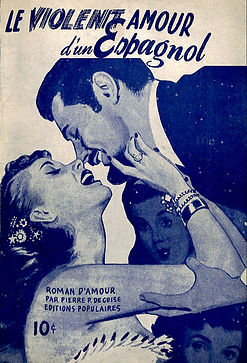Genres

The Éditions Police-Journal catalogue offers a valuable window onto popular literary genres in Quebec in the postwar period. Indeed, there is something for every taste in the different series, whose original French titles (rendered here into English) praise the exploits of decidedly patriotic heroes and heroines:
-
“The detective adventures of Albert Brien, the French Canadians’ national detective”
-
“The detective exploits of the Black Domino”
-
“The extraordinary adventures of Guy Verchères, the French-Canadian Arsène Lupin”
-
“The strange adventures of Agent IXE-13, the ace of Canadian spies”
-
“The adventures of Cow-Boys”
-
“Diane the beautiful adventurer”
-
“The futuristic adventures of two French-Canadian scientists”
-
“Love story”
A quick glance suffices to note that the keyword in these stories is “adventure.” Regardless of the genre employed (detective mystery, suspense, fantasy, spy, romance), it is the adventure, punctuated by twists and turns and ending with the hero or heroine emerging triumphant, that counts here.
While the detective, spy and adventure novels follow the evolution of a recurring hero or heroine whose escapades are renewed from one week to the next, the romance novel, for its part, systematically introduces new couples, who, despite initial setbacks, are eventually reunited. This isn’t to say that heroines and heroes like Diane the beautiful adventurer or the Black Domino don’t encounter love, nor that the heroines of romance novels don’t live adventures, quite the contrary. Close analysis of the dime novels instead reveals that their material elements – the illustrations in particular – situate them within a very precise sub-genre (romance, detective, spy), while the stories themselves strive to blur generic boundaries and play with the ingredients unique to each sub-genre. The mix seems perfectly suited to facilitating the readership’s migration from one series to another: readers are thus assured of always finding a bit of everything in every novel. This strategy is reinforced by ads placed inside the novels, encouraging readers to buy all of the series, regardless of the fictional genre on display.


